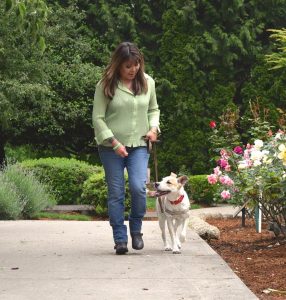How to Help your Leash-Reactive Dog
Dogs are leash-reactive for many reasons: fear, insecurity, stress, boredom, excitement, a practiced/learned behavior, and more. Often, humans fuel the fire by accidentally rewarding undesirable behaviors, which leads to a bigger problem.
How can you help your dog?
- Working through a dog’s reactivity takes practice and patience. You will need to:
- Ensure your dog doesn’t have any more negative experiences around other dogs.
- Reward your dog for appropriate behaviors.
- Set your dog up in a way that encourages appropriate behavior.
- Find a walking tool that helps with control and focus.
- The Oregon Humane Society offers Reactive Rover classes and private training consultations to help you and your dog.
 What does the training process look like?
What does the training process look like?
- Always approach training with a positive attitude, if you are feeling frustrated, stop the training and take a break.
- Choose an environment to practice where you have distance from other dogs. Distance will be key to success. Consider going for walks when it is less busy, or in quieter neighborhoods.
- Come armed with exciting treats (that he is only receiving for this practice!), a stuffed Kong, a favorite toy or all three. It never hurts to be over prepared.
- Think about exercising the dog first. Allowing the dog to play fetch or run around the yard before you practice will help burn off some steam.
- When you get the dog out to practice, reward ANY and ALL good behavior. Make sure you have a clear list in your head of acceptable behaviors; these can include looking at you, quietly looking at the other dog, sitting, moving on a loose leash, relaxed body language, etc.
- Watch your dog’s body language, so you can recognize the signs that your dog is getting overstimulated. We want to work with our dog when they are noticing the other dog, but they aren’t pulling, lunging, or are overly aroused. This distance might be further than you expect it to be.
- Increase distance when your dog is struggling. Dogs have different thresholds; learn what that distance is for your dog.
- Keep the training session short (20 minutes is sufficient), and try to always end on a good note.
Tips for success:
- Once your dog is barking and lunging at something, your best plan of action is to calmly and quickly remove him from the situation. At that moment, the emotional overload he is experiencing will prevent learning or following directions.
- Don’t worry about trying to pass another dog on the same side of the street, or getting closer to other dogs in general. It is much more important to work at a distance where your dog can be calm, to lay a solid foundation for the training.
- Consider other alternatives to physical exercise. Don’t discount mental exertion! Use puzzle toys or food dispensing toys, spend time training and teaching them new tricks, or even create your own at-home agility course to combine physical and mental stimulation. Daily enrichment is necessary for our dogs!
 Tanya Roberts is the Senior Manager of the OHS Training & Behavior Department and a Certified Professional Dog Trainer (CPDT-KA). Tanya continues her education by attending seminars and trainings so she can provide clients with current, scientifically based information. Her best teachers continue to be the wonderful animals at the Oregon Humane Society who she works with regularly during their stay.
Tanya Roberts is the Senior Manager of the OHS Training & Behavior Department and a Certified Professional Dog Trainer (CPDT-KA). Tanya continues her education by attending seminars and trainings so she can provide clients with current, scientifically based information. Her best teachers continue to be the wonderful animals at the Oregon Humane Society who she works with regularly during their stay.



